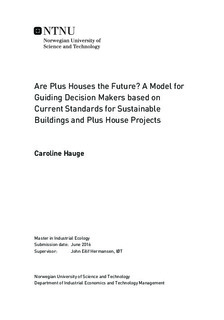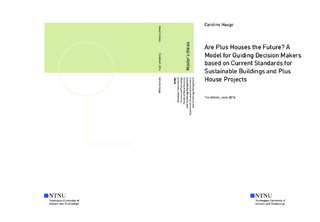| dc.description.abstract | Buildings have a massive environmental impact, both in terms of energy use and GHG emissions. However, the improvement potential is substantial. With the SDGs and the Paris Agreement, the construction sector must contribute to reach the set goals and requirements and utilize its full potential. Plus houses are one alternative to reducing the environmental impact of the construction industry.
This study provides a qualitative analysis of plus houses and other sustainable buildings and the possibilities for its expansion in Norway. Special focus is given to construction policy and existing standards for sustainable buildings. By reviewing existing research, conducting interviews and case studies, and putting the study in the context of strategic analysis, a model is created to guide decision makers on whether to construct plus houses or not. The model contains the most important factors found in this study that can influence the decision towards constructing more plus houses.
The study has indicated several important factors that are vital to consider when constructing a plus house. These include more focus on the cooperation process, setting BHAGs and budgetary restrictions and exceeding the prevailing regulations. Also, exploiting the current technology, being committed and ambitious, and using BREEAM as a basis. In addition, it can be a good idea to consider the environmental savings that can come from renovating instead of constructing new buildings. Further, the building policies in Norway are lagging behind. This is at the core of the development in the construction industry. If regulations are tightened, the construction industry must follow and the industry as a whole will reduce its environmental impact and see an increasing development.
The study has produced several recommendations, both on policy level and decision maker level. The main recommendation to policy makers are to tighten regulations today and be more ambitious when setting demands. For the decision makers, the main recommendation is to have a stronger focus on the early stages of the cooperation process and include all relevant actors in the earliest possible stage. | |

